Did you know that blanching asparagus is not only a simple and easy technique, but it also helps retain the vibrant green color and crisp texture of this versatile vegetable? Whether you’re planning to use it in salads, pasta dishes, or as a delightful side, blanching can elevate your culinary creations to new heights. Let’s explore the art of blanching asparagus and discover how to master this essential cooking technique.
Key Takeaways:
- Blanching asparagus preserves its vibrant color and crispness, making it visually appealing and delicious to eat.
- Properly trimming, buying, and storing asparagus ensures optimal freshness and quality.
- The step-by-step process of blanching asparagus involves boiling, cooling, and drying to achieve perfect results.
- Blanching asparagus is a preferred method over steaming when you want to retain its bright green color.
- Blanched asparagus can be used in salads, frozen for later use, or cooked for various recipes, unlocking a world of culinary possibilities.
Why Blanch Asparagus?
Blanching is a preferred method for cooking vegetables, including asparagus, because it helps retain the vibrant color and crispness. Unlike steaming, blanching involves quickly boiling the asparagus and then cooling it in an ice bath to stop the cooking process. This method not only preserves the nutritional value of the asparagus but also enhances its visual appeal. Blanching is particularly useful when you want to use asparagus in salads, pasta, or freezing for future use.
The Benefits of Blanching
Blanching offers several advantages over other cooking methods for asparagus. The brief boiling time helps to maintain the vibrant green color, ensuring a visually appealing presentation. It also helps preserve the crisp texture, making each bite of blanched asparagus a delightful experience.
Blanching is a tried-and-true technique that brings out the best in asparagus. It allows the natural flavors to shine and retains the appealing qualities of this versatile vegetable. Whether you want to serve it as a side dish or incorporate it into your favorite recipes, blanching is the way to go.
Blanching vs. Steaming Asparagus
When it comes to cooking asparagus, blanching and steaming are two popular methods. While both methods result in delicious asparagus, there are a few key differences to consider.
- Color and Texture: Blanching helps retain the vibrant green color and crispness of asparagus, while steaming can result in a softer texture with a slightly milder flavor.
- Speed: Blanching is a quicker cooking method, typically taking just a few minutes, whereas steaming may require a slightly longer cooking time.
- Versatility: Blanching is a versatile technique that allows you to use asparagus in a variety of dishes, including salads, pasta, or freezing for later use.
Asparagus Blanching Techniques
There are a few different techniques to blanch asparagus, depending on your preferences and the recipe you’re using. Here are two common methods:
- Whole Spear Blanching: In this method, the asparagus spears are blanched whole. Remove the tough ends, bring a pot of salted water to a boil, and cook the asparagus for a few minutes until bright green and just tender. Transfer the cooked spears to an ice bath to cool and stop the cooking process.
- Cut and Blanch: If you prefer bite-sized pieces of asparagus, you can trim the spears into smaller sections before blanching. Follow the same steps as the whole spear blanching method, but reduce the cooking time slightly to ensure the smaller pieces don’t become overcooked.
Experiment with these blanching techniques to find the one that suits your taste and cooking needs. Enjoy the vibrant green color, crisp texture, and delicious flavor of blanched asparagus in your favorite dishes.
How to Prepare Asparagus for Blanching
Before blanching asparagus, it’s important to properly prepare it. Follow these steps to ensure your asparagus is ready for blanching:
- Trimming Asparagus: Start by trimming off the tough, fibrous ends of the asparagus spears. You can either cut them with a knife or bend them until they naturally snap. Trimming the asparagus ensures that you eliminate any woody parts and are left with the tender and flavorful stalks.
- Buying Asparagus: When buying asparagus, look for bright green spears with closed tips and smooth skin. These are indicators of freshness and a good quality vegetable. Avoid purchasing asparagus with opened or slimy tips, as well as any wrinkled or dried-out stalks.
- Storing Asparagus: To keep your asparagus fresh, trim the ends and place the bunch upright in a container with cold water. This helps to keep the asparagus hydrated and maintain its crispness. Store it in the refrigerator until you’re ready to blanch it.
By properly preparing your asparagus before blanching, you’ll ensure that it cooks evenly and retains its vibrant color and delicious flavor. Now, let’s move on to the next step: a step-by-step guide to blanching asparagus!
Step-by-Step Guide to Blanching Asparagus
Blanching asparagus is a simple and effective method to preserve its vibrant color and crisp texture. Whether you want to enjoy blanched asparagus immediately or freeze it for future use, following these step-by-step instructions will ensure perfect results every time.
Here is a quick overview of how to blanch asparagus:
- Prepare an ice bath by filling a large bowl with water and ice cubes.
- In a saucepan or stockpot, bring water and salt to a boil.
- Add the trimmed asparagus spears to the boiling water.
- Cook the asparagus for 3 to 4 minutes until it turns bright green and becomes crisp-tender.
- Immediately transfer the cooked asparagus to the ice bath to stop the cooking process.
- Once the asparagus is cool, drain and pat it dry.
- For freezing, arrange the blanched asparagus in a single layer on a baking sheet lined with parchment paper.
- Freeze the asparagus until solid, then transfer it to a freezer-safe container.
Blanching preserves the vibrant color and texture of asparagus, making it an excellent choice for freezing. This technique can extend the shelf life of asparagus for up to 9 months, allowing you to enjoy the taste of fresh asparagus even when it’s out of season.
Blanching vs. Steaming Asparagus
When it comes to cooking asparagus, two common methods often come to mind: blanching and steaming. Each method has its own unique benefits and can yield different results in terms of color, texture, and flavor. Let’s take a closer look at the differences between blanching and steaming asparagus, along with the cooking methods involved.
Blanching Asparagus:
Blanching asparagus involves briefly boiling the spears before rapidly cooling them down in an ice bath. This cooking method is preferred by many because it helps retain the bright green color and crispness of the asparagus. The quick boiling process helps to lock in both the vibrant appearance and the nutritional value of the vegetable.
Here’s a step-by-step guide to blanching asparagus:
- Trim the tough ends of the asparagus spears.
- Bring a pot of salted water to a boil.
- Add the asparagus and cook for about 3-4 minutes until crisp-tender.
- Immediately transfer the cooked asparagus to an ice bath to stop the cooking process.
- Drain and pat dry before using the blanched asparagus in your desired recipe.
Steaming Asparagus:
Steaming asparagus is a gentler cooking method that involves using steam to cook the spears. This method helps to preserve the natural flavors and nutrients of the vegetable and results in a slightly softer texture compared to blanching.
Here’s how to steam asparagus:
- Trim the tough ends of the asparagus spears.
- Place a steamer basket in a pot and add water just below the bottom of the basket.
- Bring the water to a simmer.
- Arrange the asparagus in a single layer in the steamer basket.
- Cover the pot and steam the asparagus for about 5-7 minutes until tender.
- Remove the asparagus from the steamer and serve as desired.
Comparing Blanching and Steaming:
Both blanching and steaming are excellent methods for cooking asparagus, and the choice between the two depends on personal preference and the desired outcome of the dish. Here’s a quick comparison of the two methods:
| Blanching Asparagus | Steaming Asparagus |
|---|---|
| Retains bright green color | Preserves natural flavors |
| Maintains crisp texture | Results in a slightly softer texture |
| Quick cooking process | Gentler cooking method |
| Ideal for salads, stir-fries, and freezing | Great for side dishes and simple preparations |
Ultimately, whether you choose to blanch or steam your asparagus, both methods offer delicious and nutritious results. Consider the specific dish you’re preparing and the desired texture and presentation to determine which method best suits your needs. Happy cooking!
Blanching Asparagus for Salads
Blanched asparagus is a perfect addition to salads, adding a touch of crispness and vibrant color. After blanching the asparagus, you can chop it into bite-sized pieces and toss it with a variety of salad ingredients like mixed greens, tomatoes, cucumbers, and dressing. Blanched asparagus pairs well with both light vinaigrettes and creamy dressings. Experiment with different combinations to create refreshing and nutritious salads featuring blanched asparagus.
Asparagus is a nutritious and versatile vegetable that can add a burst of freshness to any salad. The blanching process helps to preserve its vibrant green color and crisp texture, making it the perfect complement to a variety of salad ingredients.
To blanch asparagus for salads, follow these simple steps:
- Trim the tough ends of the asparagus spears.
- Bring a pot of salted water to a boil.
- Add the trimmed asparagus to the boiling water and cook for about 2-3 minutes, until it becomes bright green and crisp-tender.
- Use a slotted spoon to transfer the blanched asparagus to a bowl of ice water to cool and stop the cooking process.
- Once the asparagus is cool, drain it and pat it dry with a paper towel.
- Chop the blanched asparagus into bite-sized pieces.
- Toss the chopped asparagus with your favorite salad ingredients, such as mixed greens, cherry tomatoes, cucumbers, and dressing.
- Serve your refreshing salad with blanched asparagus immediately and enjoy!
Blanching asparagus for salads not only adds a vibrant pop of color but also enhances the vegetable’s texture, creating a satisfying crunch in every bite. Whether you’re making a light summer salad or a hearty grain bowl, blanched asparagus will elevate your dish and impress your guests.
Asparagus Salad Recipe:
Servings: 4
| Ingredients | Instructions |
|---|---|
|
|
Enjoy this delicious and nutritious salad featuring blanched asparagus! The vibrant flavors and textures of the asparagus, mixed greens, and other ingredients will create a refreshing and satisfying meal. Feel free to customize the recipe with your favorite salad add-ons, such as nuts, seeds, or additional vegetables, to make it your own.
Blanching Asparagus for Freezing
Preserving asparagus for future use is a great way to ensure you can enjoy its vibrant flavor and crisp texture even when it’s out of season. To freeze asparagus, blanching is the key to maintaining its quality. Here’s how you can blanch asparagus for freezing:
- Start by preparing the asparagus. Trim off the tough ends of the spears, either by cutting them with a knife or letting them naturally snap.
- Fill a large pot with water and bring it to a boil. Add a generous pinch of salt to enhance the flavor of the asparagus.
- Meanwhile, prepare an ice bath in a large bowl by combining cold water and ice cubes.
- Once the water is boiling, carefully add the trimmed asparagus to the pot. Let it cook for about 2 to 3 minutes, or until it turns bright green and becomes slightly tender.
- Using tongs or a slotted spoon, remove the blanched asparagus from the boiling water and transfer it immediately to the ice bath. This will quickly stop the cooking process and help the asparagus retain its color and texture.
- Allow the asparagus to cool in the ice bath for a few minutes, then drain it and pat it dry gently with a clean kitchen towel or paper towels.
- Next, arrange the blanched and dried asparagus spears in a single layer on a baking sheet lined with parchment paper. This will prevent them from sticking together during freezing.
- Place the baking sheet with the asparagus in the freezer and let it freeze until the spears are solid, usually for about 1 to 2 hours.
- Once the asparagus is completely frozen, transfer the spears to a freezer-safe container or bag. Make sure to remove any excess air from the container or bag before sealing it tightly.
- Label the container or bag with the date and contents for easy reference.
- Return the asparagus to the freezer and store it for up to 9 months.
When you’re ready to use the frozen asparagus, simply remove the desired amount from the freezer and thaw it in the refrigerator overnight. Frozen blanched asparagus is perfect for adding to stir-fries, pasta dishes, soups, and more.
By blanching and freezing asparagus, you can savor its fresh flavor and texture all year round. Plus, having a stock of frozen asparagus on hand makes meal preparation quick and convenient. Enjoy the taste of summer asparagus even during the coldest months!
Blanching Asparagus for Freezing – Step by Step
| Step | Description |
|---|---|
| Step 1 | Trim the tough ends of the asparagus spears. |
| Step 2 | Boil water with salt in a large pot. |
| Step 3 | Prepare an ice bath with cold water and ice cubes. |
| Step 4 | Add the trimmed asparagus to the boiling water and cook for 2-3 minutes. |
| Step 5 | Transfer the blanched asparagus to the ice bath to cool. |
| Step 6 | Drain and pat dry the cooled asparagus. |
| Step 7 | Arrange the blanched asparagus on a baking sheet lined with parchment paper. |
| Step 8 | Freeze the asparagus until solid. |
| Step 9 | Transfer the frozen asparagus to a freezer-safe container or bag. |
| Step 10 | Label and store the frozen asparagus in the freezer. |
Blanching Asparagus for Cooking
Blanching asparagus before cooking it can greatly enhance its flavor and texture. When recipes call for cooked asparagus, blanching ensures that the vegetable is perfectly tender and retains its vibrant green color. With blanched asparagus, you can elevate a variety of dishes such as stir-fries, pasta, quiches, and more.
Blanching offers you control over the cooking process, allowing you to achieve the desired level of doneness for your asparagus. Whether you prefer a slightly crunchy texture or a softer bite, blanching provides the flexibility to cater to your personal preferences.
Asparagus Cooking Techniques
When cooking with blanched asparagus, you can explore different techniques to create delicious and visually appealing dishes. Here are a few popular cooking techniques:
- Sautéing: Heat a pan with olive oil or butter and sauté the blanched asparagus until it develops a slight char and is heated through.
- Roasting: Place the blanched asparagus on a baking sheet, drizzle with olive oil, sprinkle with salt and pepper, and roast in the oven for a few minutes until it becomes tender and caramelized.
- Grilling: Preheat the grill to medium-high heat and grill the blanched asparagus until it takes on grill marks and becomes slightly charred. This method adds a smoky flavor to the asparagus.
Feel free to experiment with different seasonings, herbs, and spices to enhance the taste of your cooked asparagus. You can also combine blanched asparagus with other vegetables, meats, or sauces to create unique and satisfying meals.
| Benefits of Blanching Asparagus for Cooking | Cooking Technique | Advantages |
|---|---|---|
| Blanching | Quick boiling and cooling in an ice bath |
|
| Other Cooking Methods | Sautéing, roasting, grilling, etc. |
|
Blanching Asparagus to Retain Color and Texture
Blanching asparagus is a technique that helps retain its vibrant green color and crisp texture. To ensure the best results, here are a few tips to keep in mind:
- Choose fresh asparagus: Select bright green spears with closed tips and smooth skin. Avoid asparagus with opened or slimy tips and check for any wrinkled or dried-out stalks.
- Trim the ends: Before blanching, trim off the tough, fibrous ends of the asparagus spears. Use a knife or bend them until they naturally snap.
- Prepare an ice bath: Fill a large bowl with water and ice cubes to create an ice bath. This will be used to quickly cool the blanched asparagus and stop the cooking process.
- Blanching time: Boil water in a saucepan or stockpot, adding a pinch of salt. Add the trimmed asparagus and cook for about 3 to 4 minutes until the spears turn bright green and become crisp-tender.
- Cool in ice bath: Immediately transfer the cooked asparagus to the prepared ice bath. Let it sit for a few minutes until completely cool. This step preserves the vibrant color and crispness of the asparagus.
- Drain and pat dry: Once the asparagus is cool, remove it from the ice bath and drain well. Gently pat dry any excess moisture before using or storing.
By following these tips for blanching asparagus, you’ll be able to achieve perfectly cooked spears with a visually appealing green color and a delightful crisp texture.
| Benefits of Blanching Asparagus | Steaming Asparagus | Roasting Asparagus |
|---|---|---|
| Retains vibrant green color | Soothing cooking method | Intensifies flavor |
| Preserves crisp texture | Retains nutritional value | Enhances caramelization |
| Can be used for salads, freezing, and cooking | Quick and convenient | Creates crispy edges |
Blanching asparagus not only helps to retain its color and texture but also preserves its nutritional value. The quick cooking and cooling process ensures that the asparagus maintains its vibrant green hue, while the crisp texture adds a delightful crunch to your dishes. Whether you’re preparing asparagus for salads, freezing it for later use, or incorporating it into various recipes, blanching is a versatile technique that enhances the overall appeal of this delicious vegetable.
Blanching Asparagus Vs. Other Cooking Methods
Blanching is a popular cooking method for asparagus, but it’s not the only option. Different cooking methods can yield slightly different results, allowing you to experiment with flavors and textures. Here’s a comparison of blanching with other common cooking methods for asparagus:
Steaming
Steaming is another gentle cooking method for asparagus that helps retain its natural color and nutrients. To steam asparagus, place it in a steamer basket over boiling water and cook until tender, usually around 4-5 minutes. Steamed asparagus maintains a crisp texture and a vibrant green color, making it a great choice for lighter dishes and salads.
Grilling
Grilling asparagus adds a smoky and charred flavor to the vegetable, enhancing its natural sweetness. To grill asparagus, brush the spears with olive oil, season with salt and pepper, and grill over medium-high heat for about 4-5 minutes, turning occasionally. Grilled asparagus pairs well with grilled meats and can be served as a side dish or added to salads for added depth of flavor.
Roasting
Roasting asparagus brings out its natural sweetness and intensifies its flavors. To roast asparagus, preheat the oven to 425°F (220°C). Toss the asparagus with olive oil, salt, and pepper and spread it out in a single layer on a baking sheet. Roast for about 12-15 minutes until the asparagus is tender and slightly crisp. Roasted asparagus is delicious on its own or as an accompaniment to roasted meats or poultry.
Sautéing
Sautéing asparagus in a hot pan with oil or butter is a quick and easy cooking method that yields tender and flavorful results. Heat a skillet over medium-high heat, add the asparagus, and cook for about 5-7 minutes, stirring occasionally until it becomes tender-crisp. Sautéed asparagus is versatile and can be used in a variety of dishes like stir-fries, pasta, or served as a side dish with grilled meats.
Each cooking method offers a unique taste and texture to asparagus, allowing you to choose the one that best suits your preference and complements your dish. Whether you prefer the crispness of blanched asparagus or the smoky flavor of grilled spears, experimenting with different cooking methods can open up a world of culinary possibilities.
Conclusion
Blanching asparagus is a simple and versatile cooking technique that can elevate the flavor, color, and texture of this nutritious vegetable. With just a few easy steps, you can blanch asparagus perfectly every time, whether you’re using it in salads, freezing it for future use, or incorporating it into various recipes.
Experimenting with different seasonings, dressings, and cooking methods can help you create delicious dishes featuring blanched asparagus. The vibrant and crisp results of blanching bring out the best in asparagus and open up a world of culinary possibilities.
So, the next time you want to enjoy asparagus, remember the blanching technique. Whether you prefer a refreshing asparagus salad, a comforting pasta dish, or a flavorful stir-fry, blanching asparagus will help you achieve the perfect balance of taste and texture. Follow this blanching asparagus guide and discover the joy of cooking with this versatile vegetable!

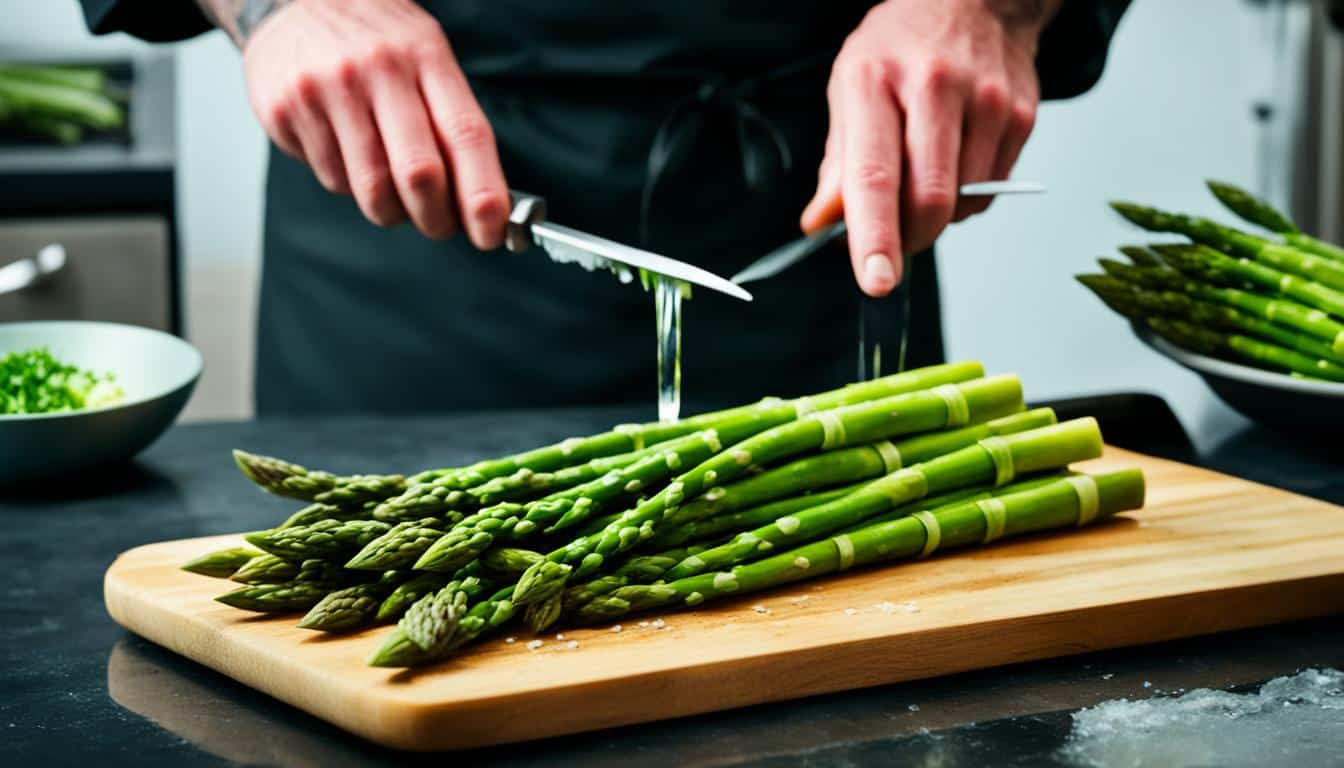
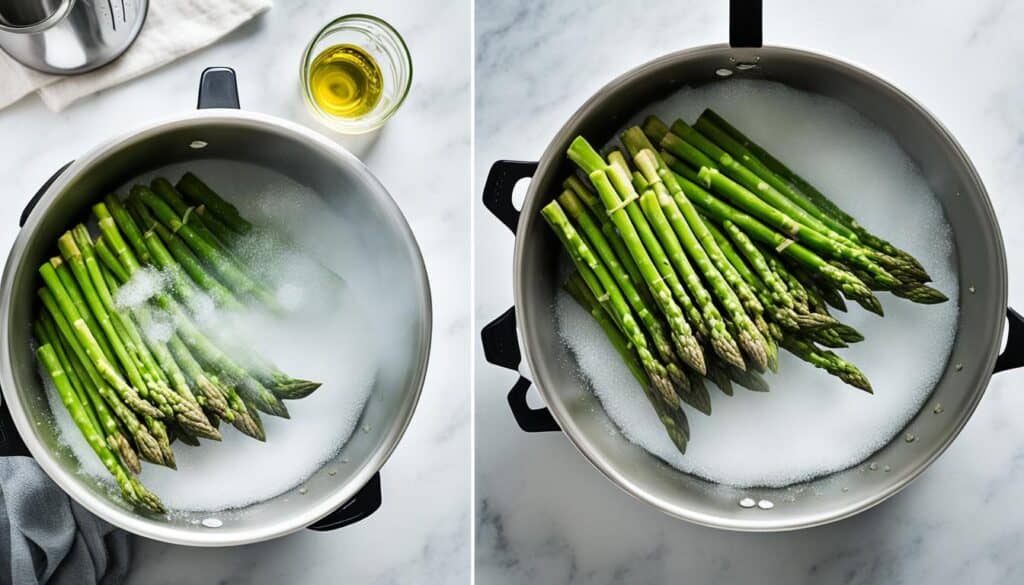
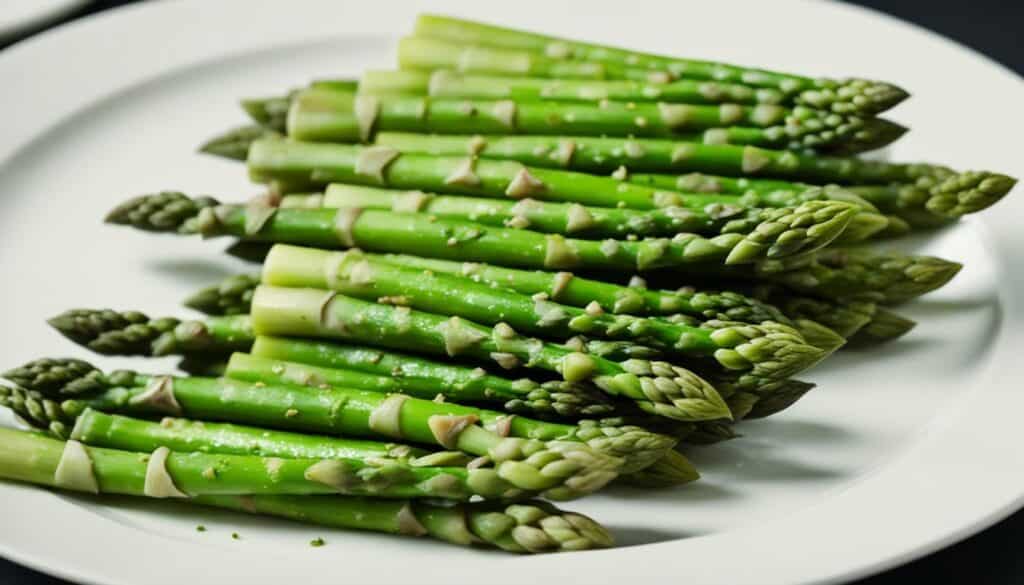
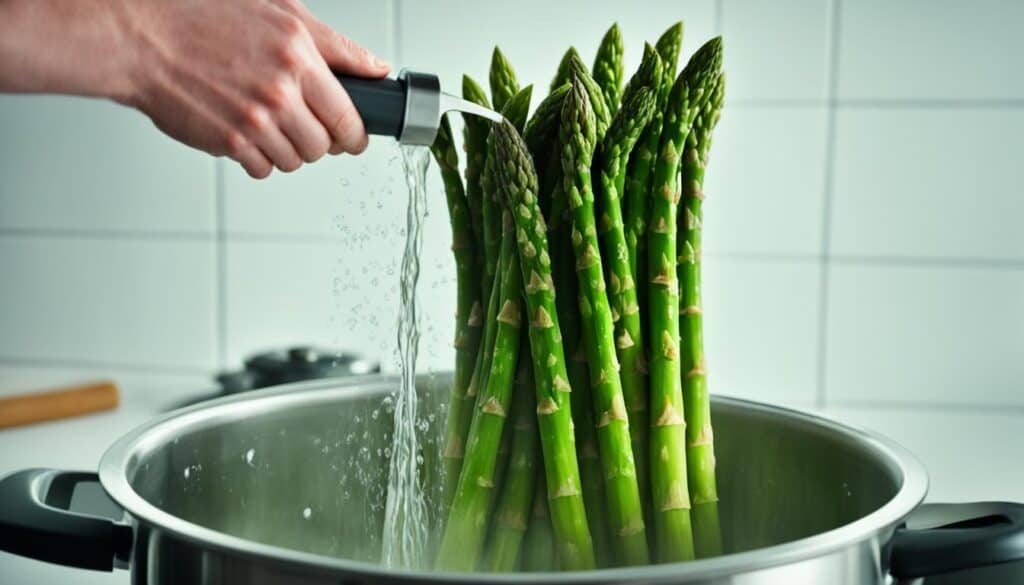
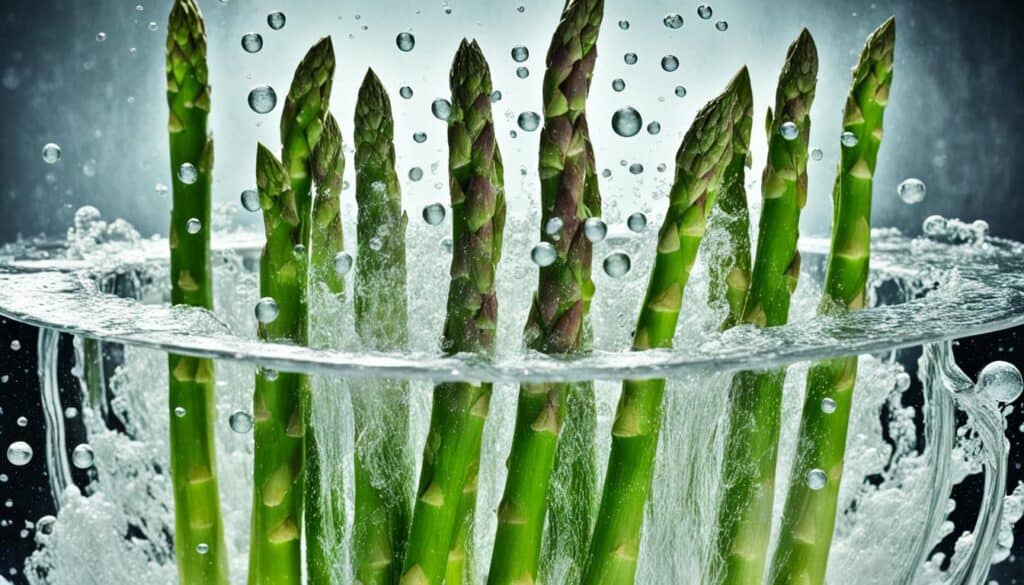
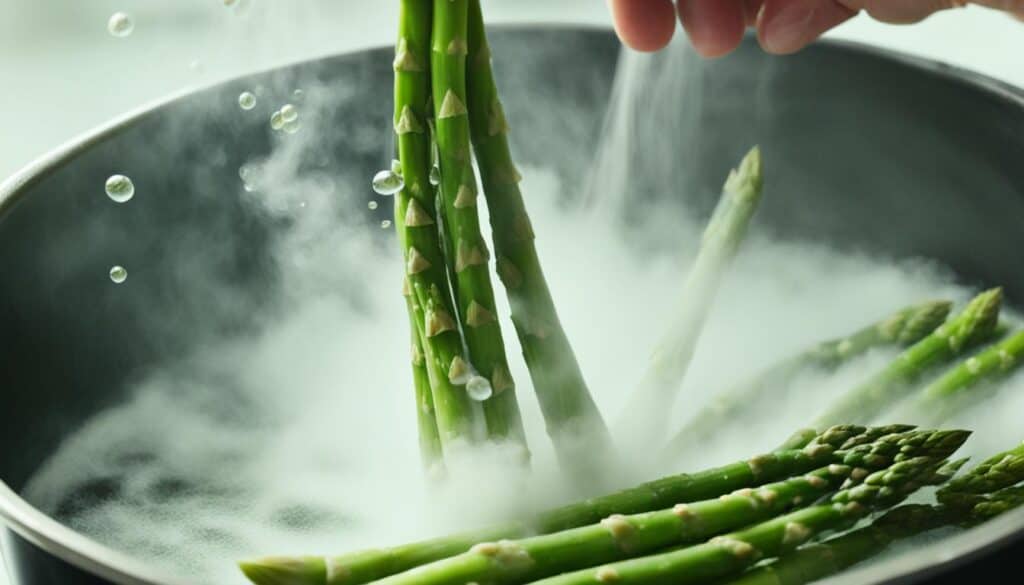



Leave a Reply